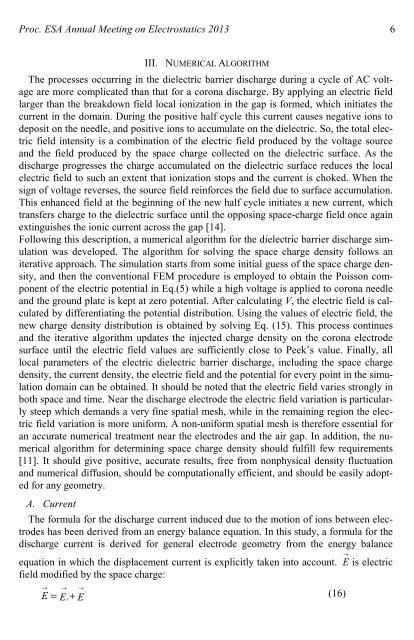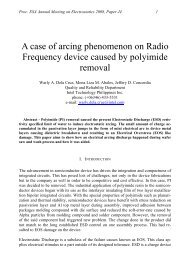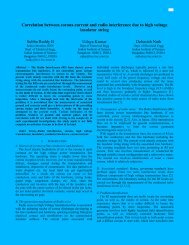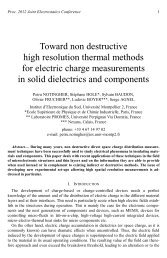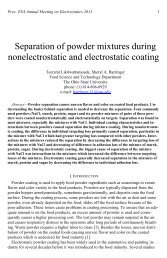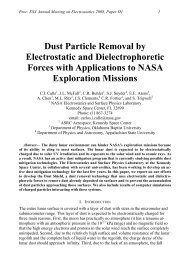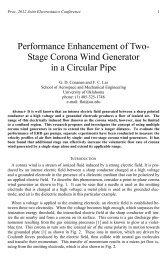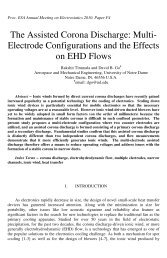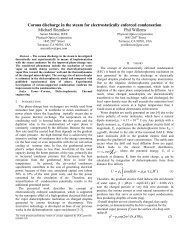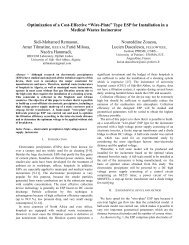Quasi-stationary numerical model of the dielectric barrier discharge
Quasi-stationary numerical model of the dielectric barrier discharge
Quasi-stationary numerical model of the dielectric barrier discharge
Create successful ePaper yourself
Turn your PDF publications into a flip-book with our unique Google optimized e-Paper software.
Proc. ESA Annual Meeting on Electrostatics 2013 6III. NUMERICAL ALGORITHMThe processes occurring in <strong>the</strong> <strong>dielectric</strong> <strong>barrier</strong> <strong>discharge</strong> during a cycle <strong>of</strong> AC voltageare more complicated than that for a corona <strong>discharge</strong>. By applying an electric fieldlarger than <strong>the</strong> breakdown field local ionization in <strong>the</strong> gap is formed, which initiates <strong>the</strong>current in <strong>the</strong> domain. During <strong>the</strong> positive half cycle this current causes negative ions todeposit on <strong>the</strong> needle, and positive ions to accumulate on <strong>the</strong> <strong>dielectric</strong>. So, <strong>the</strong> total electricfield intensity is a combination <strong>of</strong> <strong>the</strong> electric field produced by <strong>the</strong> voltage sourceand <strong>the</strong> field produced by <strong>the</strong> space charge collected on <strong>the</strong> <strong>dielectric</strong> surface. As <strong>the</strong><strong>discharge</strong> progresses <strong>the</strong> charge accumulated on <strong>the</strong> <strong>dielectric</strong> surface reduces <strong>the</strong> localelectric field to such an extent that ionization stops and <strong>the</strong> current is choked. When <strong>the</strong>sign <strong>of</strong> voltage reverses, <strong>the</strong> source field reinforces <strong>the</strong> field due to surface accumulation.This enhanced field at <strong>the</strong> beginning <strong>of</strong> <strong>the</strong> new half cycle initiates a new current, whichtransfers charge to <strong>the</strong> <strong>dielectric</strong> surface until <strong>the</strong> opposing space-charge field once againextinguishes <strong>the</strong> ionic current across <strong>the</strong> gap [14].Following this description, a <strong>numerical</strong> algorithm for <strong>the</strong> <strong>dielectric</strong> <strong>barrier</strong> <strong>discharge</strong> simulationwas developed. The algorithm for solving <strong>the</strong> space charge density follows aniterative approach. The simulation starts from some initial guess <strong>of</strong> <strong>the</strong> space charge density,and <strong>the</strong>n <strong>the</strong> conventional FEM procedure is employed to obtain <strong>the</strong> Poisson component<strong>of</strong> <strong>the</strong> electric potential in Eq.(5) while a high voltage is applied to corona needleand <strong>the</strong> ground plate is kept at zero potential. After calculating V, <strong>the</strong> electric field is calculatedby differentiating <strong>the</strong> potential distribution. Using <strong>the</strong> values <strong>of</strong> electric field, <strong>the</strong>new charge density distribution is obtained by solving Eq. (15). This process continuesand <strong>the</strong> iterative algorithm updates <strong>the</strong> injected charge density on <strong>the</strong> corona electrodesurface until <strong>the</strong> electric field values are sufficiently close to Peek’s value. Finally, alllocal parameters <strong>of</strong> <strong>the</strong> electric <strong>dielectric</strong> <strong>barrier</strong> <strong>discharge</strong>, including <strong>the</strong> space chargedensity, <strong>the</strong> current density, <strong>the</strong> electric field and <strong>the</strong> potential for every point in <strong>the</strong> simulationdomain can be obtained. It should be noted that <strong>the</strong> electric field varies strongly inboth space and time. Near <strong>the</strong> <strong>discharge</strong> electrode <strong>the</strong> electric field variation is particularlysteep which demands a very fine spatial mesh, while in <strong>the</strong> remaining region <strong>the</strong> electricfield variation is more uniform. A non-uniform spatial mesh is <strong>the</strong>refore essential foran accurate <strong>numerical</strong> treatment near <strong>the</strong> electrodes and <strong>the</strong> air gap. In addition, <strong>the</strong> <strong>numerical</strong>algorithm for determining space charge density should fulfill few requirements[11]. It should give positive, accurate results, free from nonphysical density fluctuationand <strong>numerical</strong> diffusion, should be computationally efficient, and should be easily adoptedfor any geometry.A. CurrentThe formula for <strong>the</strong> <strong>discharge</strong> current induced due to <strong>the</strong> motion <strong>of</strong> ions between electrodeshas been derived from an energy balance equation. In this study, a formula for <strong>the</strong><strong>discharge</strong> current is derived for general electrode geometry from <strong>the</strong> energy balanceequation in which <strong>the</strong> displacement current is explicitly taken into account. → E is electricfield modified by <strong>the</strong> space charge:→→→'E = E s+E(16)


